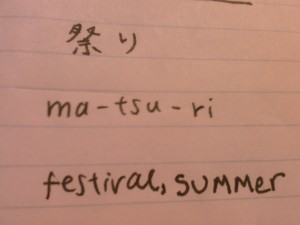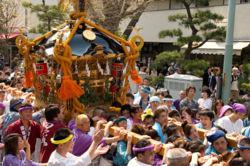(Original Kanji)
(Japanese in English)
(English Translation)
Mikoshi at Kamakura 2007
Seiko Takeshita Summer Festival
During the summer time in Japan, every town holds a festival known as mat-tsu-ri. Mat-tsu-ri translates directly to festival, and it is one of the biggest celebrations that the Japanese hold every year. The sizes of the festivals vary from location to location. The smaller towns and villages hold smaller versions of the mat-tsu-ri festival while big cities hold extravagant and opulent festivals where thousands and thousands of people attend. People come to the festivals to relax and have fun. There is lots of food, games, and attractions for everyone to do. Seiko said the main food that is eaten is cotton candy and chocolate-covered bananas. At some of the biggest locales, fireworks are even set off at the end of the festival. The mat-tsu-ri festival is the biggest cultural event that occurs during the summer, and is something that every Japanese person looks forward too.
At these festivals, there are traditional garments that are worn by the women who attend. They are called Yukatas, and are a variation of another traditional garment known as the kimono. This robe was frequently worn by many women in ancient Japan but is no longer seen in common culture. The mat-tsu-ri festival is one of the only times of the year when it is customary to wear this traditional clothing.
Another tradition regularly seen at the mat-tsu-ri festival is the inclusion of the very old transportation carriage known as a mikoshi. It was once used as a royal family transportation device so they could safely be carried within the festival. Now the mikoshi is no longer used as transportation but merely as a symbol representing the mat-tsu-ri festival and honoring ancient Japanese culture. (Picture of a mikoshi can be found at the beginning of this essay.) Among the other activities that are performed at the festival, Seiko said she remembers playing with bouncy balls and water balloons quite frequently when she attended. There is also a cultural Japanese dance known as the bon-odo-ri that people would take part in. The crowd could join in and have a fun time with their friends and family.
The mat-tsu-ri festival is great example of a traditional cultural event which unites the Japanese and allows them to gather together in their respected locations and enjoy themselves. There are many festivals similar to this all around the world which vies to achieve the same unifying goal. The purpose of festivals is to bring people together who might not originally have met and promote communion among the people attending. Ultimately the principle of a festival is to have a good time. And from Seikos description of the festival, its clear that she always has a wonderful experience.
Annotation:
Journal Article:
Roemer, Michael K. “Ritual Participation and Social Support in a Major Japanese Festival.” Journal for the Scientific Study of Religion 46 (2007): 185-200.





